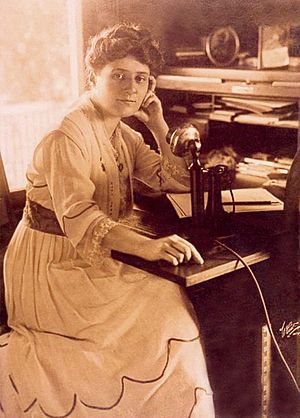Edna Buckman Kearns facts for kids
Edna Buckman Kearns (December 25, 1882 – June 1, 1934) was an important activist who fought for women's right to vote. She worked hard in New York campaigns in 1915 and 1917. She also helped the National Woman's Party push for the 19th Amendment. This amendment gave women the right to vote across the United States.
Edna is best known for her special horse-drawn wagon. It was called the “Spirit of 1776.” She used it in parades and events in New York City and Long Island. The wagon helped gather support for women's voting rights. Today, this historic wagon is kept at the New York State Museum. It has been shown in exhibitions, including one at the New York State Capitol in 2012.
Contents
Early Life and Family
Edna May Buckman was born on December 25, 1882. Her parents were Charles Harper Buckman and Mary “May” Begley. She grew up in Philadelphia, Pennsylvania. Her family also lived in Montgomery County. Edna was the oldest child; she had a brother named Thomas.
The Buckman family were members of the Quakers. This is a religious group known for its peaceful beliefs. Edna graduated from Friends' Central School in Philadelphia. Her mother, May Buckman, was also an activist. She worked with the temperance movement, which aimed to reduce alcohol use.
Edna's family had a long history in America. Her ancestors came to Philadelphia with William Penn in 1682. They were one of the largest families on the ship Welcome. These early family members bought land and farmed in Bucks County.
Marriage and Move to New York
On June 8, 1904, Edna May Buckman married Wilmer Rhamstine Kearns. They had a Quaker wedding ceremony. After their marriage, they moved to New York City. Wilmer Kearns worked there in an accounting office.
Their first child, Serena Buckman Kearns, was born in August 1905. When Serena was old enough to go to school, Edna became very active in the suffrage movement. The family bought a home in Rockville Centre, New York, around 1907. Edna spent her time organizing for the right to vote in both New York City and Long Island.
Fighting for the Vote
In 1913, a company called I.S. Remson gave an old wagon to the New York State Woman Suffrage Association. This wagon was named the “Spirit of 1776.” The president of the association, Harriet May Mills, gave the wagon to Edna Kearns. Edna used it to organize suffrage events on Long Island.
The wagon's first public appearance was in July 1913. This event was even covered by newspapers like the New York Times. Edna Kearns took on important roles in suffrage clubs in Nassau and Suffolk County. She also became a writer and editor for the Brooklyn Daily Eagle around 1911. She wrote about the suffrage movement for local, state, and national campaigns.
Edna often took her daughter, Serena, with her on trips in the “Spirit of 1776” wagon. Serena became a symbol for the suffrage movement. Edna's husband, Wilmer Kearns, also supported the cause. He marched in men's divisions of suffrage parades in New York City and Washington, D.C.. Edna Kearns also represented Alice Paul and the National Woman's Party on Long Island. She helped with the campaigns to pass and approve the 19th Amendment.
Edna Kearns also used her writing skills to help the New York Yearly Meeting of Quakers. She was part of their Publicity Committee from 1913 to 1917. She helped news reporters understand the Quaker organization better. She even pointed out that the Quaker Oats Company was not founded by Quakers. She felt the company was using the Quakers' good reputation for business.
Edna worked with many other suffrage activists on Long Island. These included Rosalie Gardiner Jones, Ida Sammis, Ida Craft, Elisabeth Freeman, and Alva Belmont. Besides fighting for votes for women, Edna Buckman Kearns was also active in peace groups. She was involved before and during World War I. She served on the board of the Women's International League for Peace and Freedom until 1919.
Later Life and Legacy
In 1920, Wilmer and Edna Kearns moved back to Echo Dale, the Buckman family home. Their second child, Wilma Buckman Kearns, was born there on November 12, 1920. Wilma was part of the first generation of American girls who would have the right to vote for their entire lives. Interestingly, Wilma's birthday was also the birthday of Elizabeth Cady Stanton. Stanton was a famous women's rights activist from New York State.
Edna and Wilmer Kearns started a plant nursery called Echo Dale Gardens. They specialized in annuals and perennials. Wilmer Kearns ran the nursery until the 1950s. The nursery also displayed the suffrage wagon. It helped teach people about its importance in history.
In 1932, Pennsylvania Governor Gifford Pinchot appointed Edna Buckman Kearns to a special board. This board helped mothers in Montgomery County. Edna Kearns was also active in local Pennsylvania groups that supported business and professional women. She passed away in June 1934 from cancer. She is buried in the Quaker cemetery in Plymouth Meeting, Pennsylvania.
The historic suffrage wagon was returned to New York State in 1986. It was part of an exhibit in Kingston, New York. The wagon has been shown twice since it became part of the New York State Museum's collection.



